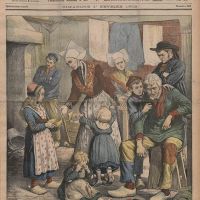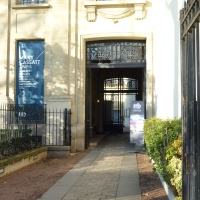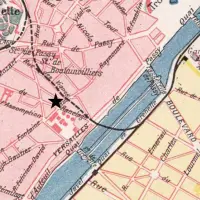Everyone who knows us knows we love the city, and we are often asked for suggestions about what to do and see. Here are some of the things we tell people.
We should start by mentioning that we dislike standing in long queues when there are more interesting things we could be doing, and we do have to watch our budget. So we have never been up the Eiffel Tower, we prefer small museums to the Louvre, we do not have the maitre d’s of the top restaurants on speed-dial, and we travel in the off-season. We also find that when the weather is good, we want to be outside walking; we go to museums and galleries when it rains.
A good place to ask questions in English: Any English-language bookstore. We were delighted when The Red Wheelbarrow bookshop, run by a fellow Canadian, reopened on the Left Bank (it used to be in the Marais and we were very sad when it closed a few years earlier). Meanwhile, Smith & Son (formerly W.H. Smith) and Galignani on the rue du Rivoli and Shakespeare and Company near Notre-Dame are still going strong.
How to buy Métro tickets: Tickets are available at machines in every Metro station. You can use them for a journey of Métro-plus-bus, as they are valid for an hour or so once they’ve been stamped. You can also buy a ticket that is good for as many trips as you want to make in one day. Otherwise, the Navigo card is available as a weekly pass (good from Monday to Monday only, though, or by calendar month). You’ll need a photo for this, but as anyone who has seen Amélie knows, there are photo booths in most large Metro stations and train stations.
How to see Paris by bus: No need to sign up for one of those monster tour buses. Get a Metro ticket and hop on the regular No. 69 bus. It travels between the Champs de Mars near the Eiffel Tower on the Left Bank and a Metro station on the far side of the Père Lachaise cemetery on the Right, crossing the river and passing Les Invalides, the Musée d’Orsay, the Louvre, the Place de la Bastille, and the trendy area north of the Faubourg St-Antoine. Buses have an automatic system that calls out the stops, so you will know what is what. Best deal in town. The No. 72 bus is another good bet, following the Right Bank of the river on its eastward journey from the Porte de St-Cloud to the Gare de Lyon (the westward route veers inland for a stretch, but passes the Louvre and the Palais Royal).
How to see Paris from the river: Take the Batobus. You buy a ticket that is good for the whole day and can get on and off at any of the stops. This is more fun than taking a regular river tour, where you are stuck on the boat until the end. And you can get off to have a decent lunch wherever you like.
How to see Paris from the Canal St-Martin: Two companies offer trips – Canauxrama and Paris Canal. We recommend Paris Canal. The trip starts near the Musée d’Orsay at 10:00 a.m. or 3 p.m. and ends two and a half hours later in the huge Bassin de la Villette in the northern part of the city. You have to reserve online in advance.
Where to buy anything you forgot to bring: Monoprix has stores throughout the city, including some all-food stores called Monop’ where you can get prepared meals. We’ve bought clothing, food, gifts, toiletries, extra suitcases… you name it, there. It’s inexpensive, and a fun place to browse. Another favourite is the BHV (Bazar de l’Hotel de Ville) on the rue de Rivoli, near the Hotel de Ville (City Hall). The kitchenwares department is heaven for foodies, Norman loves the basement hardware section, and the stationery department offers gifts galore.
How to get good service in shops: When you enter a boutique, take a moment to look around for the shopkeeper, make eye contact, and say “Bonjour.” This sends the signal that you have good manners and you will usually receive better service.
Where to get a good view of the city for free: The department stores on the Right Bank, Galeries Lafayette and Printemps, have roof decks where you get a splendid view of the city. Although they offer rooftop cafés too, you don’t have to buy food there to enjoy the view. You can also go to the Centre Georges Pompidou and say you are going to the bar called Georges. The elevator to Georges is separate from the regular entrance and you can enjoy the view without entering the restaurant. The restaurant interior is quite eye-popping, though, and not a bad place to have a glass of wine (we’ve never eaten there). Finally, the Montparnasse Tower Observation Deck offers a splendid view over the Left Bank, but it is not free.
Where to get a light meal: If you go to anything that calls itself a restaurant, you may be expected to eat a full, multi-course meal at midday or in the evening (after 7 p.m.). If you want a light lunch or a snack or a modest dinner, or anything at all before 7 p.m. when the formal restaurants open, try a bistro, brasserie, café, or salon de thé.
Another type of lunch: Buy food at a market and make a picnic in the nearest park. A handy guide called Markets of Paris by Dixon and Ruthanne Long (now into a second edition) offers details on which open-air markets are open when, and what you will find when you get there. A baguette, some cold meat, cheese, fruit, and a half-bottle of rosé makes a splendid picnic lunch on the banks of the Seine or in a city park.
Where to pick up bargains: The flea market at the Porte de Vanves in the southern part of the city is a relaxed and informal market open Saturday and Sunday mornings. Not everything is super cheap, but bargains are there if you look. It’s like wandering through the attic of a French grandmother who has never thrown anything away since the turn of the last century. We’ve bought silver, glassware, old Metro signs, Ricard water jugs like those in retro cafés, and so forth. Vanves is smaller and more accessible than the huge market to the north of the city (Clignancourt) and the neighbourhood is nicer. When you are finished, you can ride on the ultra-modern tram through some very pretty parts of the city, past the Cité Universitaire and the Parc Montsouris.
How to check the weather forecast: The Paris Metéo site forecasts are usually pretty accurate.
How to find what’s on at museums, theatres and galleries: Go to a newsstand and ask for l’Officiel des Spectacles. It’s in French, but it’s a mine of information on opening times and prices. (Note that “tlj sf lundi” means open every day except Monday.)
Where to watch the world go by: The cafés on the big boulevards and in the tourist areas are often overpriced and the food is nothing special. Smaller streets are usually a better bet, and the people you will be watching won’t all be other tourists.
What to do if you feel unwell: Go to a pharmacie. They are indicated by an illuminated green cross. The larger pharmacies in the central areas should have someone who speaks some English. Pharmacists will not only suggest helpful medications for whatever ails you, but if they think that you might need a doctor’s help, they can often suggest one who will see you fairly quickly by appointment (better than trying your luck at a hospital emergency ward) or give you the address of the nearest S.O.S. Médecins (a walk-in clinic).
How to behave: Paris is a big city, and like all big cities, it has pickpockets who operate wherever there are big crowds, as well as red-light districts, some rougher neighbourhoods, and so on. Keep your valuables close to you, don’t flash a lot of bling, and after dark, keep to well-lighted, well-travelled streets, especially if you are on your own. If someone approaches you on the street offering to sell something they have just “found,” such as a piece of jewellery, move away. It’s a popular scam.
Where to find a toilet when you need one: Department stores, museums, large hotels, and very busy cafés are your best bet (where there are crowds, nobody notices you are not there to eat). You are also permitted to use restrooms in some of Paris’s grandest buildings: the city halls in each of the twenty arrondissements. There are street toilets, most of them free, but they often have line-ups and are inevitably out of service when you are desperate.
More questions? Ask us: parisianfields@gmail.com.
For more advice, visit “Girl’s Guide to Paris” for Philippa’s article on “Paris for First-Timers.”























Great advice! Smiling and saying Bonjour, Merci, etc will take you a long way in Paris.
We will be in Paris the first week of December (re-booked from spring trip cancellation due to volcano)…we will be prepared for cold wet weather but would appreciate anyone’s suggestions on clothing and things to do in inclimate weather in this beautiful city….merci!
We love Paris in December! Take your smartest coat or raincoat and a selection of scarves (or buy some nice ones there), as well as gloves. You can buy a cheap folding umbrella there at Monoprix (or a lovely expensive one to bring home as a souvenir). December is great for Christmas window shopping and other kinds of shopping, museum-going, and when the weather turns mild (as it often does in winter), long walks, including in the late afternoon, when the sky darkens, but all the lights are on in the houses, restaurants, and shops. Exploring an area like the Marais late in the day can be magical. Earlier in the day, the bare trees make for wonderful photographs. Winter street markets are fun and generally protected from the elements. There are also special booths set up near places like Galeries Lafayette that sell holiday items. Look for special holiday pastries — you will see amazing ones at Le Notre — and decorations in the streets. They may or may not have put up the special lights on the Champs-Elysees, but do check it out. Have a wonderful time!
Great tips – thanks! Headed there in April for first time as a surprise 50th birthday present for my wife. I have an apartment in La Marais and now just trying to plan a 7 day itinerary. Your advice is certainly helpful.
We have stayed in the Marais in an apartment and recommend it highly. You could spend the whole seven days without leaving the quartier. The Hotel Carnavalet has good exhibits, and the permanent collection is free. Take a stroll around the Place des Vosges and the garden of the Hotel de Sully. The Village St Paul is a wonderful little enclave to explore. And there are shops galore on all the little winding streets. April is beautiful, with blossoms and flowers everywhere. You and your wife will be enchanted!
Do you have time to elaborate on places/cafes where you may linger over coffee and enjoy Le Marais? I too (with three other family members) will be staying in an apartment there for a week in early July and am looking for relaxing and easily accessable nearby escapes (from what will undoubtedly be a crowded and lively flat).
We’re going to break the list down into “places” and “cafés” since the Marais offers plenty of relaxing escapes both with and without food.
Places
1. Stroll through the Village St-Paul (http://village-saint-paul.com/), which is an interlocking series of courtyards with tiny boutiques selling everything from antiques to unique inventions. This wonderful example of historic preservation is bounded to the north by the rue Charlemagne, to the east by the rue St-Paul, to the south by the rue de l’Ave Maria and to the west by the rue des Jardins St-Paul and there are entries off all four streets.
2. The gardens of the Hotel de Sens/Bibliothèque Forney are glorious and should be filled with roses in July. Enter off the rue du Figuier.
3. The enclosed garden beyond the Hotel de Sully is a delightful oasis, just off the more crowded Place des Vosges. Enter off the rue St-Antoine. The stone benches are cool in summer.
4. On the east side of the Bassin de l’Arsenal are some terraced and shady gardens overlooking the water.
5. If the weather is iffy, take refuge in the Musée Carnavalet, which is free and fascinating. It is a museum of Paris itself, featuring everything from a recreation of Proust’s cork-lined room to an entirely Art Nouveau room that positively writhes with flowing lines.
For a meal, coffee, or glass of wine
1. When we want an inexpensive mid-morning coffee or lunch in the Marais, we head to the pretty courtyard of the Swedish Cultural Centre (Institut Suédois), just behind the Hotel Carnavalet on the rue Payenne.
2. There are cafés on every boulevard, but some are underwhelming. We’ve always had good experiences at the Café Sully on the corner of the Boulevard Morland and the boulevard Henri IV, just around the corner from the Pavillon de l’Arsenal (which is also free and has exhibitions on Paris architecture in both English and French). Le Sully is an ordinary French café/bistro with a typical menu, but a good example of the genre.
3. The Framboisy on the rue Charlemagne is in a quiet corner on a narrow street with tables inside and out.
4. Stop at La Belle Hortense, rue Vieille du Temple, for a glass of wine in a library-like setting. It’s a wine bar/bookstore combination we find irresistible. We’ve been known to hole up in the back room with reading material for hours.
5. In the more northerly reaches of the Marais, we like the Marché des Enfant-Rouges, where there is a small café and some interesting and unusual shops. Enter from the rue de Bretagne. This whole area is off the tourist track, but fun to explore.
6. Not too far away is a funny little corner near our favourite spice shop, Goumanyat/Thiercelin. There are two cafés on the rue Dupetit-Thouars opposite the old covered market, the Carreau du Temple, which will eventually be renovated as some kind of recreational space. But if you have a taste for history, you are sitting opposite the site of the former Temple, where the Royal Family was imprisoned during the Revolution. It can send a shiver up your spine even on a hot day.
Pingback: The queen in the tower | Parisian Fields
Love this info! merci!
Manners are all important I think especially in cafes/shops/bistros etc… I have always been treated exceptionally well when I simply make eye contact, say ‘bonjour’ and smile… simple easy, common sense really! Thanks for sharing your invaluable advice!
Like you, I adore Paris. I’m Dutch, living near Amsterdam and I love going to Paris! Many years ago I discovered that cycling in Paris is the best way to see the town. As I did it many times I composed and published a cycling guide, full of pictures of very special places and undiscovered parts of the town. As I see that the bike hire company ‘Paris à vélo, c’est sympa’ is mentioned on your site, I dare to advise you to use my cycling guide. Till now I did not make an English version, but if your French is OK, look at the cycling guide in French (A Paris à vélo): http://www.parisavelo.fr, or for the Dutch version (Parijs per fiets): http://www.fietsenparijs.nl.
By the way, ‘Paris à vélo, c’est sympa’ likes the guide that much that he has both versions in his shop! Enjoy your bike-ride!!
I’d like to do Paris on Velib, even tho I’m 65. However, my debit card doesn’t have a ‘chip’ and my credit union doesn’t offer them. Any suggestions?
Hi Rob,
According to the New York Times travel magazine that arrived just this morning, the usual advice is “Bring your American Express card; Velib’ machines are not compatible with Visas and MasterCards that do not have a European chip.” (http://tmagazine.blogs.nytimes.com/2012/03/12/french-velorution/). Do not despair, though. The alternative is to take a guided bicycle tour. We did one with a company called Paris à vélo, c’est sympa! (http://www.parisvelosympa.com/en/). It was our first experience of bicycling in the city, and it was helpful not to have to worry about directions, but simply follow a leader who knew the route. We found it well-organized and the route took us through some areas of the city that were new to us, an extra benefit. We recommend it highly.
Norman and Philippa
Hi Norman and Philippa and Rob!
Like you and many other people I love cycling in Paris. Years ago I also made a cycling tour with the company you mentioned: Paris à vélo, c’est sympa!, and it was a real ‘treat’! Since then every time I was in Paris, I continued cycling and discovering the city on my own, and I developed a cycling guide with 3 long (25 km) tours through nice and quiet areas, but still in the center of Paris. As I am Dutch, it is available in Dutch (Parijs per fiets, http://www.fietsenparijs.nl) and in French, because I translated it (À Paris à vélo, http://www.parisavelo.fr). Unfortunately I did not translate it in English till now. But if Dutch or French is no problem for you, have a look at the websites: it might be interesting for you!
Good luck!
Joke Radius
Thank you for this article. I have also created a website about Paris Subway : http://www.paris-metro-pass.com
Pingback: Blogging for France… « Whatever takes my fancy
Hi Norman and Philippa!
Your blog is really interesting. I ve subscribed !
A new way to visit Paris is by scooter. http://parisbyscooter.com/paris-in-a-day-tour/
Adventurous clients have a lot of fun : http://parisbyscooter.com/pictures-of-paris-france/
How can we contact you ?
Best,
Xavier
Dear Xavier,
Thanks for your note. The scooter tours look enjoyable. We are not in Paris at the moment, but perhaps we will try one on our next visit.
Norman and Philippa
Norman and Philippa,
Thanks for your kind reply.
I started a blog and was wondering if you would accept to exchange a link an your blog roll ? here is my address : http://parisbyscooter.com/paris/paris-review-blog/
And my email is paris @ parisbyscooter.com
Hope I didn t disturb you,
All the best,
Xavier
I have been visiting Paris ever since I was a school teacher assigned to Canada’s DND Schools Overseas in Metz back in the 1960s but I have learned more on your site about the City of Light than on all of my travels. I am now a freelance writer and military author (see my blog coordinates below) and my wife and I (she is also a published author) are writing a book about cities, towns and villages on the Western Front that were destroyed and then rebuilt after World War One. We’re based in Burlington, Ontario. I’d welcome the opportunity to “chat” with you on a less public forum than this one. If that’s of any interest, please email me. In the meantime, you might be interested in this article that has appeared in several publications: http://tomdouglas.typepad.com/tom_douglas/2010/08/say-what-you-want-about-paris-just-dont-say-it-to-me.html
Pingback: The once and future Paris transport museum | Parisian Fields
PHSC Photographic Historical Society of Canada Available on-line at: http://daguerre.org/mem_quarterly.php Owing to their recent 2013 Paris Symposium, The Daguerrian Society Quarterly – Vol. 25, No. 3 (July-September 2013)pp. 25-29 presents 5 fascinating, densely texted pages with page titles: “French Culture, Customs, and Etiquette”, “French Etiquette (How Not to Act Like Such A Tourist)”, from: “The most important details of French etiquette in everyday Parisian life…”, Paris-Culture-Guide.com, c2010-2013; “Cell Phone Information For Paris”; Paris Information” re: Paris Metro Pass, Paris Conversion from U.S. Dollars to Euros, Paris Time. The same information is probably also just as relevant for non-Daguerrians visiting Paris from North America.
Hello Philippa. How wonderful that we met last Sunday chez May. This is a wonderful blog. I am sending it to my cousin in England, with whom I travelled to Paris, this last November 3 weeks ago.
Thanks, Jenny
Hi ,to complete your blog from the point of view of a native parisian, here’s a few tips on how to blend http://leschroniquesdurerb.blogspot.fr/2014/08/how-to-blend-in-paris.html feel free to read it. cheers
I very much enjoyed your blog, Parisian Fields. I am working on a history book-blog of my own, which can be seen at [one word] theoryofirony.com, then clicking on either the “sample chapter” or “blog” buttons at the top. My Rube Goldberg brain asks with an odd, well-caffeinated kind of logic: Why is there an inverse proportion between the size of the print and the importance of the message? Art. Literature. Science. Commerce. Military. Religion. I call this eccentric thinking the Theory of Irony and if your busy schedule permits, give a read, leave a comment or create a blogroll link. In any event, best of luck with your own endeavors.
P.S. It concerns Classical, Medieval and Modern eras.
What a helpful post. We are headed to Paris this fall and we are SO excited! 🙂
Have a wonderful time. The fall is a lovely season for visiting the city. All the best, Norman and Philippa
Pingback: A web of friends and a ceremony in a former corset factory | Parisian Fields